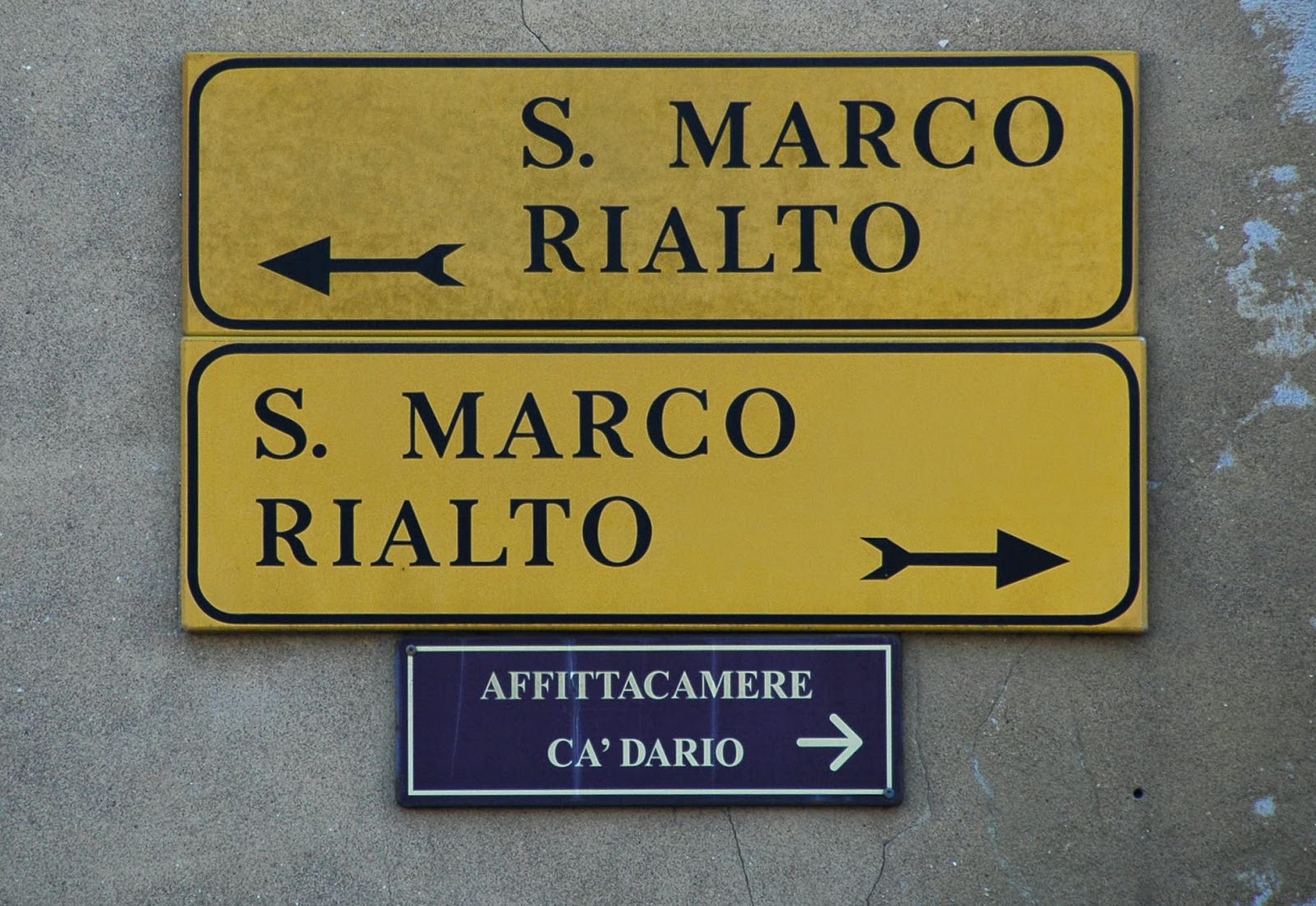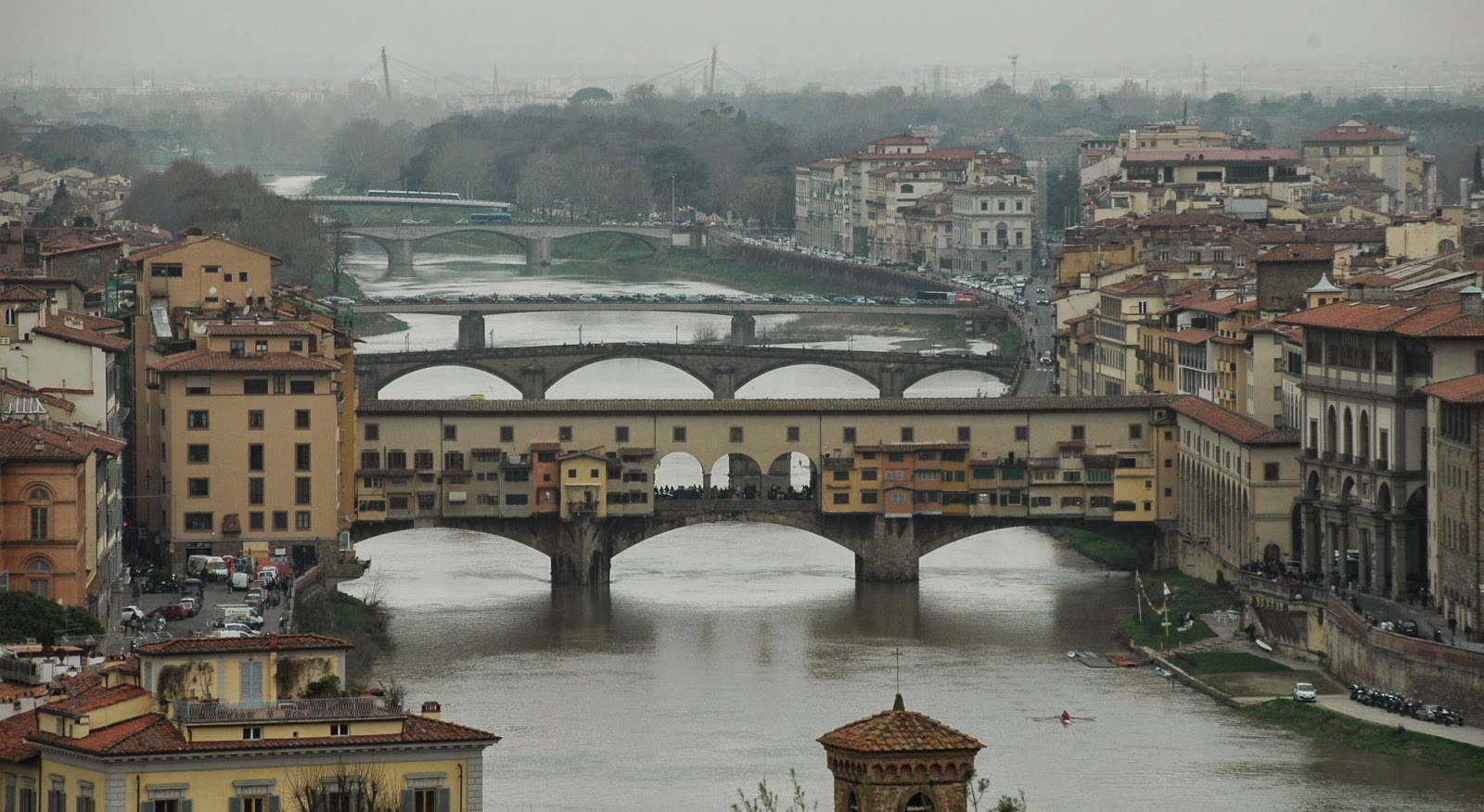Our first day in Venezia! We bought our bus ticket in and out, and caught the bus into Piazzale Roma, the huge bus station at the western (landward) end of the islands. From there, we walked the way towards Piazza San Marco, and St Mark's Basilica, St Mark's Campanile, the Doge's Palace, and so much more!
The path takes you through winding back streets, but it is always clearly marked at every turn "Per S. Marco", so it's hard (but not impossible) to get lost! (There are also signs leading "Per Rialto", "Per P.le Roma" — the street name signs are always black and white, and the directional signs brown and black or brown and white.) We noted one sign that could have been confusing, but as all roads lead to Rome, both these paths lead to Piazza San Marco.
When we got to the square, the first thing we did was to go into the Basilica. It's free to go in, but inside there are extra 'added attractions', like going up to the Terrace outside overlooking Piazza San Marco, and to the museum just behind the Terrace, that you are asked to pay for. Totally worth while — the four horses on the front of the Basilica were captured by the Fourth Crusade in Constantinople in 1204 and returned to Venice. Actually, the horses out front are copies, but the originals are in the museum — you can see the quality in them when you meet them face-to-face!
You are not supposed to take photos inside the Basilica, but so many people were doing so that Warren decided to follow suit. He was very lucky, in that a tour guide had just turned on the lights onto the mosaics that cover the interior. Magic! We have dropped Ravenna and its mosaics out of our itinerary for the moment, but to be here just at this time was superb! Venice (specifically, the island of Murano) is world-famed for its glass, and the St Mark's mosaics take full advantage of glass tesserae cut from Murano glass!
The floors are tiled in various marbles and other stones, with different designs in different parts of the cathedral — at times we had tha feeling that our old friend M.C. Escher had been here!
The floors are tiled in various marbles and other stones, with different designs in different parts of the cathedral — at times we had tha feeling that our old friend M.C. Escher had been here!
A musical note — St Mark's architecture was responsible for the development of the Venetian polychoral style of music, with two or more separated choirs singing motets, taking advantage of the temporal separation of the singers across the intervening space. St Marks has two opposing choir galleries, and it was from this that the style developed. Warren had the pleasure some years ago of taking part in a polychoral concert in St Paul's Cathedral in Melbourne, singing the music of Gabrielli, Willaert and Monteverdi, amongst others!
We then went outside and walked the square, stopping for a coffee at one of the cafes there, and walked the waterfront quite a way to the east, to where we had had a cup of coffee seven years ago. On the way, we passed one of the major ports of call in any gondola ride — the Bridge of Sighs (between the prison and the Doge's Palace where the prisoners learned their fates). The lion of Venice keeps on cropping up on the buildings, on flags, on statues. The Lion is St. Mark himself, the patron saint of Venice. The inscription on the book it is holding is "Pax tibi Marce Evangelista Meus" (May Peace be with you, Mark my evangelist).
As we walked around Venice, we passed numerous stores that sold Murano Glass, and more that sold Carnevale masks. Carnevale is quite a festival in Venice. It runs up to Mardi Gras (Shrove Tuesday), the beginning of Lent. In other places, Carnival only lasts a couple of weeks. In Venice, however, the wearing of Carnival Masks is allowed between St Stephen's Day (December 26) and Mardi Gras, and also on Ascension Day (39 days after Easter, and between October 5 and Christmas, so Carnevale effectively lasts for about six months! The Government reinstituted the official Venetian Carnival in 1979 as a tourist attraction, and it has gone from strength to strength!
Anyway, all good days must at some time come to an end, even for gondoliers! We wandered our way back out of town, passing by the Rialto Bridge, passing one of the emergency vehicles on the canal (we had to step out of the way as they took the patient down to the ambulance in a red wheelbarrow!) and took the bus back to the campsite — to the tune of a friendly songbird!
Distance driven — today, nil; to date, 16,786 miles ( 27,015 km )











































































